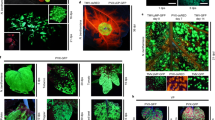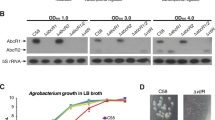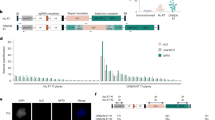Abstract
The plant pathogen Agrobacterium tumefaciens can induce crown gall tumours in a wide range of dicotyledonous plants. To be virulent an Agrobacterium strain must contain a tumour-inducing (Ti) plasmid1,2. Most Ti plasmids fall into one of two groups, based on whether they code for enzymes for octopine or nopaline utilisation3,4. Tumours induced by strains carrying octopine or nopaline type Tiplasmids generally synthesise octopine or nopaline respectively3,4. Normal plant tissues do not synthesise these unusual amino acid derivatives5,6. Chilton et al.7 have analysed total DNA isolated from a cloned sterile tobacco crown gall callus and found sequences (T-DNA) complementary to ∼5% of the Ti plasmid that are not found in normal tobacco callus. Thus, Agrobacterium can induce and maintain tumours by introducing genetic information stably into plant cells. It is evident that plasmid sequences have a central role in Agrobacterium virulence. Based on metabolic and physiological properties, most isolates of A. tumefaciens can be classified as either biotype 1 or biotype 2 organisms8,9. They have a broad host range, inducing tumours on most dicotyledonous plants. Recently, however, strains isolated in Greece and Russia from grapevine tumours have been shown to have a limited host range10,11. These organisms are also unique in that they do not fit into either of the previously described biotypes and have therefore been assigned to a new class, biotype 3 (refs 11, 12). We felt that these limited host range organisms could provide a system to study determinants of host range: if host range is determined solely by plasmid genes, the transfer of the Ti plasmid from a limited host range biotype 3 organism (assuming the biotype 3 organism had a Ti plasmid) to a biotype 1 organism that had been cured of its Ti plasmid, should yield a transformant of limited host range. The transformant should have a wide host range if this is a chromosomally borne trait. In this report we present data suggesting that the Ti plasmid has a major role in determining host range.
This is a preview of subscription content, access via your institution
Access options
Subscribe to this journal
Receive 51 print issues and online access
$199.00 per year
only $3.90 per issue
Buy this article
- Purchase on Springer Link
- Instant access to full article PDF
Prices may be subject to local taxes which are calculated during checkout
Similar content being viewed by others
References
VanLaebeke, N. et al. Nature 252, 169–170 (1974).
Watson, B., Currier, T. C., Gordon, M. P., Chilton, M.-D. & Nester, E. W. J. Bact. 123, 255–264 (1975).
Bomhoff, G. H. et al. Molec. gen. Genet. 145, 177–181 (1976).
Montoya, A. L., Chilton, M.-D., Gordon, M. P., Sciaky, D. & Nester, E. W. J. Bact. 129, 101–107 (1977).
Kemp, J. D. Biochem. biophys. Res. Commun. 69, 816–822 (1976).
Bomhoff, G. H. thesis, Univ. Leiden (1974).
Chilton, M.-D. et al. Cell 11, 263–271 (1977).
Keane, P. F., Kerr, A. & New, P. B. Aust. J. biol. Sci. 23, 585–595 (1970).
Kersters, K., DeLey, J., Sneath, P. H. A. & Sackin, M. J. gen. Microbiol. 78, 227–239 (1973).
Panagopoulos, C. G. & Psallidas, P. G. J. appl. Bact. 36, 233–240 (1973).
Panagopoulos, C. G., Psallidas, P. G. & Alivizatos, A. S. Proc. 4th. Int. Conf. PI. Path. Bact. Angers (1978).
Kerr, A. & Panagopoulos, C.G. Phytopath. Z. 90, 172–179 (1977).
Holsters, M. et al. Molec. gen. Genet. 163, 181–187 (1978).
Casse, F., Boucher, C., Julliot, J. S., Michel, M. & Dénarié, J. J. gen. Microbiol. (in the press).
Schroth, M. N., Thompson, J. P. & Hildebrand, D. C. Phytopathology 55, 645–647 (1965).
Sciaky, D., Montoya, A. L. & Chilton, M.-D. Plasmid 1, 238–253 (1978).
Lippincott, B. B. & Lippincott, J. A. J. Bact. 97, 620–628 (1969).
Lippincott, B. B., Whateley, M. H. & Lippincott, J. A. Pl. Physiol. 59, 388–390 (1977).
Matthysse, A. G., Wyman, P. M. & Holmes, K. V. Infect. Immun. 22, 512–522 (1978).
Smith, V. A. & Hindley, J. Nature 276, 498–500 (1978).
Smith, H. W. & Linggood, M. A. J. med. Microbiol. 5, 243–250 (1972).
Smith, H. W. & Linggood, M. J. med. Microbiol. 4, 467–486 (1971).
Loper, J. E. & Kado, C. J. Bact. 139, 591–596 (1979).
Currier, T. C. & Nester, E. W. Analyt. Biochem. 66, 431–441 (1976).
Author information
Authors and Affiliations
Rights and permissions
About this article
Cite this article
Thomashow, M., Panagopoulos, C., Gordon, M. et al. Host range of Agrobacterium tumefaciens is determined by the Ti plasmid. Nature 283, 794–796 (1980). https://doi.org/10.1038/283794a0
Received:
Accepted:
Issue Date:
DOI: https://doi.org/10.1038/283794a0
This article is cited by
-
In Vitro Antibacterial Activity of Cysteine Protease Inhibitor from Kiwifruit (Actinidia deliciosa)
Indian Journal of Microbiology (2013)
-
Establishment of an Agrobacterium-mediated transformation system for grape (Vitis vinifera L.): The role of antioxidants during grape–Agrobacterium interactions
Nature Biotechnology (1996)
-
Mapping and genetic organization of pTiChry5, a novel Ti plasmid from a highly virulent Agrobacterium tumefaciens strain
Molecular and General Genetics MGG (1994)
-
Functional analysis of a complex oncogene arrangement in biotype III Agrobacterium tumefaciens strains
Plant Molecular Biology (1990)
-
Nucleotide sequence, evolutionary origin and biological role of a rearranged cytokinin gene isolated from a wide host range biotype III Agrobacterium strain
Molecular and General Genetics MGG (1989)
Comments
By submitting a comment you agree to abide by our Terms and Community Guidelines. If you find something abusive or that does not comply with our terms or guidelines please flag it as inappropriate.



